Morse code, or CW, is a subject that divides the amateur radio community from top to bottom. For some it’s a faded anachronism, while for others it’s the purest form of the art. With it no longer in significant commercial or military use it is radio amateurs who keep it alive, and those for whom it is a passion devote considerable effort to its continuing use.
With well over a century of history behind it there are a huge array of morse keys available to the CW enthusiast. From vintage telegraph keys through WW2 surplus military keys to sideways “bug” keys and modern boutique handcrafted keys, many operators will amass a collection for the love of it, and regularly use them all.

Other operators create their own keys, either crafting them from raw materials or using whatever materials they have at hand. Keys have been made from every conceivable piece of junk that will conduct electricity, and made contacts to all parts of the world.
[H. P. Friedrichs, AC7ZL] has produced such a home-made key from surplus material, but it has nothing of the junkbox about it. He’s used the head actuator from a surplus hard drive as the arm of a straight key, and the result is an item of beauty. The actuator bearing is the pivot point, and the business end of the key replaces the hard drive’s heads. The spring is provided by the repulsive force between magnets, the connection at the rear is provided by a piece of guitar string, and the contacts themselves are taken from a surplus power relay. Even his write-up is a thing of beauty, a compelling read with hand-drawn illustrations. If you are not a Morse enthusiast it’s still an engaging project.
We’ve featured many keys here over the years, and this isn’t the first one using a hard drive actuator, as this mint tin paddle shows. Among others we’ve linked you to a collection of unorthodox keys, and of course shown you a vintage telegraph key with a Raspberry Pi decoder.
















Every hard drive I no longer want (and that includes lots I’ve never used), I take apart for the magnets, worth the effort in itself.
But I keep the platters and some of the mechanical pieces, simply because they look so nice. I’ve never found a use for them, but if all the things I’ve taken apart, hard drives look good, beyond practical use of mechanical pieces.
Michael
platters make nice wind-chimes and bird-scarers.
And Tesla Turbines.
and CO2 laser mirrors.
And gyroscopes.
and HDD Clocks
Especially HDD clocks!
https://hackaday.com/2012/01/21/trashed-hard-drive-why-not-an-engraved-clock/
Same here. I wish I had some way of recycling all that beautiful aluminium too.
The drive cases are mu-metal, useful for magnetic shielding.
I don’t think then entire drive casing is made of mu-metal, just the part around the magnets.
Pretty sure drive casings are aluminum.
Is the voice coil active for receiving? If not then it should be.
For receiving what? As removed from a hard drive the coil my not be useful in receiver that used to receive and RF of interest.
I think he means active as in used as an actual voice coil and move when receiving morse code. It would be a great improvement on this build and wouldn’t take much more to make it work, could add a single magnet beside the coil.
I think that kind of thing used to be called a ‘sounder’ in telegraph.
An interesting idea would be to implement closed loop control (without the platter) and use the arm as a kind of registration device. Not necessarily for morse.
Beautiful work! Like others, I’ve harvested many an old drive. And have a box of bits that I’ve done little with. The last Hamfest I attended I purchased a vintage Morse code practice key set. I managed to clean it up and get working. I think I will put this on my project list. Thank you for sharing your work.
KF7HMY
Morse code and CW are two completely different things. Morse code is a mapping of a character set, CW is a modulation scheme. You can send all sorts of different things using CW other than Morse code, and you can send Morse code over all manner of modulation schemes.
True, but in the context of the amateur radio community the terms tend to be synonymous.
I once used the head actuator from a hard drive to make a mechanical thumb. I was going to attach it to my cast, back in 2006, when I broke my thumb, but never finished. I only got the idea about half way through, and with only 1 arm, it took over a week to scavenge and assemble parts. With a week left, I said “meh”…
I regret the “meh” to this day… I could have been a CYBORG!!! :P
Navies across the globe continue to use Morse code in the form of flashing light signalling between ships.
https://www.youtube.com/watch?v=WOt83AouoGU